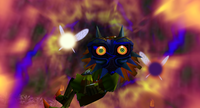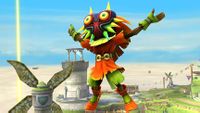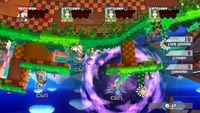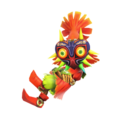Skull Kid
| Skull Kid | |
|---|---|
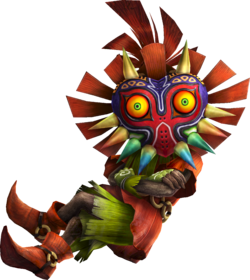 
Official artwork of Skull Kid from Hyrule Warriors Legends. | |
| Universe | The Legend of Zelda |
| Debut | The Legend of Zelda: Ocarina of Time (1998) |
| Smash Bros. appearances | Brawl SSB4 Ultimate |
| Most recent non-Smash appearance | Hyrule Warriors: Definitive Edition (2018) |
| Console/platform of origin | Nintendo 64 |
| Species | Skull Kid |
| Gender | Male |
| Voice actor | Sachi Matsumoto |
| Article on Zelda Wiki | Skull Kid |
Skull Kids (スタルキッド, Stal Kid) are recurring characters in The Legend of Zelda series. They appear in Super Smash Bros. Brawl as stickers. The one from The Legend of Zelda: Majora's Mask appears in Super Smash Bros. 4, wearing the titular mask, as an Assist Trophy.
Origin[edit]
Skull Kids first appeared in The Legend of Zelda: Ocarina of Time as minor characters, with one in particular who befriends Link once he plays Saria's Song to him and rewards Link with a piece of heart. In The Legend of Zelda: Majora's Mask, a Skull Kid becomes a central character. Lonely and depressed due to a lack of friends, he is shunned and downtrodden by the people of Termina because of his many tricks and pranks. Still, he managed to find companionship in Fairy siblings Tatl and Tael. One day, he manages to steal a mask from the Happy Mask Salesman. This mask was Majora's Mask, which corrupts him when he puts it on. He now wished to destroy all of Termina by striking it with the Moon. He crosses Link during this time, which sets the events of the game into motion. This Skull Kid is the basis for Super Smash Bros. 4's Assist Trophy. A Skull Kid also appears as a minor character in The Legend of Zelda: Twilight Princess, who plays hide and seek as a form of guidance towards the Master Sword and the Temple of Time and as a miniboss who sends shadow puppets to attack Link.
The Skull Kid's attack as an Assist Trophy is not based on any known ability of Majora's Mask itself, although Skull Kid has been seen using the power of the mask to curse people for his own amusement. Two of his attacks, however, have a mechanic that makes reference to the Stone Tower and its respective temple, which must be inverted for Link to progress.
In Super Smash Bros. Melee[edit]
Skull Kid himself did not appear, but he was mentioned in the description of the Four Giants trophy and the Majora's Mask trophy.
In Super Smash Bros. Brawl[edit]
Skull Kids appear on two stickers in Brawl.
Stickers[edit]
| Name | Game | Effect | Fighter(s) |
|---|---|---|---|
| Skull Kid | The Legend of Zelda: Majora's Mask | ||
| Skull Kid | The Legend of Zelda: Ocarina of Time |
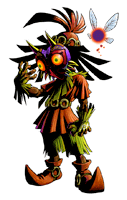 Skull Kid (Zelda Majora's Mask) |
 Skull Kid (Zelda Ocarina of Time) |
In Super Smash Bros. 4[edit]
As an Assist Trophy[edit]
The Skull Kid from The Legend of Zelda: Majora's Mask appears in Super Smash Bros. 4 as an Assist Trophy. As one of the Tips mentions, Skull Kid is one of the only Assist Trophies to have potentially detrimental effects to both enemies and the user. When he appears, he can do one of three things, chosen at random:
- Flips the camera upside-down, as well as mirroring it.
- Reverses all directional inputs for all players, so left is right and up is down. This does not apply to taunts.
- Turns all fighters invisible.
Skull Kid has a spawn chance of 38/1254. He cannot be summoned on the following stages in a standard versus match (applies to both games and only the base form unless noted otherwise):
- 3D Land
- Arena Ferox
- Dream Land (64) (all)
- Hyrule Castle (64) (all)
- Jungle Japes (all)
- Magicant
- Mario Circuit
- Midgar (all)
- Onett
- Pac-Land (Omega)
- Peach's Castle (64) (all)
- Reset Bomb Forest
- Skyloft
- Super Mario Maker (all)
- Tortimer Island
- Umbra Clock Tower (all Wii U)
Skull Kid cannot be summoned if the following items are active and vice versa:
- Items: a third Daybreak part, a third Dragoon part, and Smash Ball.
- Poké Ball Pokémon: Palkia, Togepi, Victini, and Zoroark.
Trophy[edit]
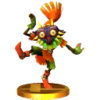
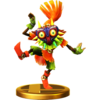
- Skull Kid
It's said that children who get lost in the forest are turned into these music-loving little monsters. In Smash Bros., you can summon one who's sporting Majora's Mask. It'll move into the background and bring down a world of chaos on the whole stage. Even the fighter who summoned him will be affected, so try to keep a level head!
: The Legend of Zelda: Ocarina of Time (11/1998)
: The Legend of Zelda: Majora's Mask (10/2000)
It's said that children who get lost in the woods are turned into these music-loving little monsters. You can summon one in Super Smash Bros. Wearing Majora's Mask, it'll move into the background and bring down a world of chaos on the whole stage. Even the fighter who summoned him will be affected, so try to keep a level head!
: The Legend of Zelda: Ocarina of Time (12/1998)
: The Legend of Zelda: Majora's Mask (11/2000)
In Super Smash Bros. Ultimate[edit]
As an Assist Trophy[edit]
Skull Kid once again returns as an Assist Trophy from Super Smash Bros. 4. Training Mode describes his Assist Trophy: Does disruptive things like turning the stage upside down or making fighters invisible. Can't be KO'd.
Skull Kid has a spawn chance of 32/2086. He cannot be summoned on the following stages in a standard versus match (applies to both games and only the base form unless noted otherwise):
- 3D Land
- Arena Ferox
- Dream Land (all)
- Hyrule Castle (all)
- Jungle Japes (all)
- Magicant
- Mario Circuit
- Midgar (all)
- Pac-Land (Omega, Battlefield)
- Peach's Castle (all)
- Reset Bomb Forest
- Skyloft
- Spear Pillar
- Super Mario Maker (all)
- Tortimer Island
- Umbra Clock Tower (all)
- WarioWare, Inc.
Skull Kid cannot be summoned if the following items are active and vice versa:
- Items: Boss Galaga, a third Daybreak part, a third Dragoon part, and Smash Ball.
- Poké Ball Pokémon: Palkia, Togepi, Victini, and Zoroark.
- Assist Trophies: Andross, Arcade Bunny, Ashley, Color TV-Game 15, Devil, Dr. Kawashima, Flies & Hand, Moon, Nightmare, Nikki, Nintendog, Squid Sisters, Thwomp, Vince, and Yuri Kozukata.
As a costume[edit]
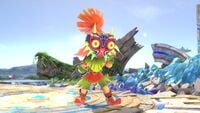
Skull Kid serves as the basis for the Skull Kid's Hat Headgear and the Skull Kid's Outfit for the Mii Brawler.
Spirit[edit]
Skull Kid also appears as two different primary spirits.
In Adventure Mode: World of Light, Skull Kid is presumably one of the countless spirits captured by Galeem during his takeover of the universe. After Galeem's defeat, Dharkon takes control of Galeem's spirits, including Skull Kid. Skull Kid's spirit is located in the Sacred Land sub-dungeon of The Dark Realm.
Skull Kid's Spirit Battle uses a Mii Brawler puppet fighter wearing a Skull Kid's Hat and Outfit and can be fought on the Distant Planet stage. He is fought along two Tiny Meta Knight puppet fighters representing Skull Kid's fairy companions, Tatl and Tael. During the battle, Skull Kid appears as a hostile Assist Trophy while the stage is covered in fog. Also, the puppet fighters start the battle with increased move speed.
Skull Kid & Majora's Mask can be obtained by enhancing the Skull Kid spirit at level 99.
Gallery[edit]
Names in other languages[edit]
Trivia[edit]
- Prior to patch 1.0.6, Skull Kid was referred to as "Bimbo Perduto" ("Lost Kid") in the Italian version of Smash 4. With the patch his Italian name was changed to his English name "Skull Kid" for the trophy and the tip about the corresponding Assist Trophy.
- Usually, when Skull Kid makes the fighters invisible, they stay invisible upon losing a life. However, if this happens in Smash Tour, the newly-respawned character will become visible.
- If Skull Kid flips the screen in Training Mode, the training menu and info will also be flipped.
- Conversely, if a character is out of the camera's view and taking Magnifying-glass damage during a standard match, the hoop will point at the character's actual location, instead of following the flipped camera view.
- Skull Kid is one of the few Assist Trophies to be revealed on the Super Smash Bros. Ultimate website rather than in a Nintendo Direct.
